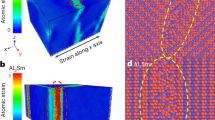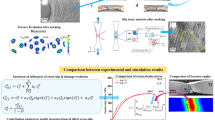Abstract
Shear bands are very common microstructural features in metals undergoing high plastic deformation. In processes like cold rolling, shear banding plays an essential role in obtaining the desired crystallographic texture. However, the exact deformation mechanism of shear bands is yet to be fully understood. This work explores the modeling of shear band formation and the effect of orientation of the crystal, prior to the deformation, through single crystal simulations. The effect of crystal orientation and crystallographic anisotropy on shear band formation is studied using a gradient damage model coupled with plasticity and crystallographic information. It is observed that the orientation affects shear band thickness and the strain at which shear bands are formed.







Similar content being viewed by others
References
J.A. Hines, K.S. Vecchio, and S. Ahzi: Metall. Mater. Trans. A, 1998, vol. 29A, pp. 191–203.
Q. Xue and G.T. Gray: Metall. Mater. Trans. A, 2006, vol. 37A, pp. 2435–46.
Q. Xue and G. Gray: Metall. Mater. Trans. A, 2006, vol. 37A, pp. 2447–58.
J. Cheng and S. Ghosh: Comput. Mater. Sci., 2013, vol. 69, pp. 494–504.
Y. Long, L. Peng, W. Zhang, H. Peng, J. Zhang, and X. Huang: Metall. Mater. Trans. A, 2020, vol. 51A, pp. 2064–71.
M.C. Jo, S. Kim, H.K. Park, S.S. Hong, H.K. Kim, H.S. Kim, and S. Lee: Metall. Mater. Trans. A, 2020, vol. 51A, pp. 3384–91.
D. Dorner, Y. Adachi, and K. Tsuzaki: Scripta Mater., 2007, vol. 57(8), pp. 775–78.
N. Jia, D. Raabe, and X. Zhao: Acta Mater., 2014, vol. 76, pp. 238–51.
N. Jia, P. Eisenlohr, F. Roters, D. Raabe, and X. Zhao: Acta Mater., 2012, vol. 60(8), pp. 3415–34.
H. Zbib and E. Aifantis: Acta Mech., 1992, vol. 92(1), pp. 209–25.
J. Pamin: Comput. Mater. Sci., 2005, vol. 32(3), pp. 472–79.
L.Z. Mansouri, H. Chalal, and F. Abed-Meraim: Mech. Mater., 2014, vol. 76, pp. 64–92.
H.-B. Mühlhaus and E. Alfantis: Int. J. Solids Struct., 1991, vol. 28(7), pp. 845–57.
A. Menzel and P. Steinmann: J. Mech. Phys. Solids, 2000, vol. 48(8), pp. 1777–96.
E. Kuhl and E. Ramm: Comput. Mater. Sci., 1999, vol. 16(1), pp. 176–85.
A. Emdadi and M. Asle Zaeem: Comput. Mater. Sci., 2021, vol. 186, p. 110057.
N. Zhao, A. Roy, W. Wang, L. Zhao, and V.V. Silberschmidt: Mech. Mater., 2019, vol. 130, pp. 29–38.
E. Tanné, T. Li, B. Bourdin, J.-J. Marigo, and C. Maurini: J. Mech. Phys. Solids, 2018, vol. 110, pp. 80–99.
K. Pham, H. Amor, J.-J. Marigo, and C. Maurini: Int. J. Damage Mech, 2011, vol. 20(4), pp. 618–52.
S. Karthik, A. Rajagopal, and J. Reddy: Mech. Mater., 2021, vol. 157, p. 103797.
T.K. Mandal, V.P. Nguyen, and J.-Y. Wu: Eng. Fract. Mech., 2020, vol. 235, p. 107169.
R. Alessi: (Ph.D. thesis), Ecole Polytechnique X, 2013, https://pastel.archives-ouvertes.fr/pastel-00847970.
R. Alessi, J.-J. Marigo, and S. Vidoli: Mech. Mater., 2015, vol. 80, pp. 351–67.
S. Brach, E. Tanné, B. Bourdin, and K. Bhattacharya: Comput. Methods Appl. Mech. Eng., 2019, vol. 353, pp. 44–65.
E. Tanné: (Ph.D. thesis), Universite Paris-Saclay, 2017, https://pastel.archives-ouvertes.fr/tel-01758354.
R. Alessi, J.-J. Marigo, C. Maurini, and S. Vidoli: Int. J. Mech. Sci., 2018, vol. 149, pp. 559–76.
T.C.T. Ting: Anisotropic Elasticity: Theory and Applications, Oxford University Press, Oxford, 1996, pp. 32–64.
S.S. Rao: Engineering Optimization Theory and Practice, Wiley, Hoboken, 2019, pp. 347–448.
M.A. Msekh, J.M. Sargado, M. Jamshidian, P.M. Areias, and T. Rabczuk: Comput. Mater. Sci., 2015, vol. 96, pp. 472–84.
C. Geuzaine and J.-F. Remacle: Int. J. Numer. Methods Eng., 2009, vol. 79(11), pp. 1309–31.
K. Spencer, S. Corbin, and D. Lloyd: Mater. Sci. Eng. A, 2002, vol. 325(1), pp. 394–404.
G.E. Dieter and D. Bacon: Mechanical Metallurgy, McGraw-hill, New York, 1986, pp. 103–44.
W.F. Hosford: The Mechanics of Crystals and Textured Polycrystals, Oxford University Press, Oxford, 1994, pp. 532–32.
Competing interests
The authors declare that they have no conflict of interest.
Author information
Authors and Affiliations
Corresponding author
Additional information
Publisher's Note
Springer Nature remains neutral with regard to jurisdictional claims in published maps and institutional affiliations.
Rights and permissions
Springer Nature or its licensor (e.g. a society or other partner) holds exclusive rights to this article under a publishing agreement with the author(s) or other rightsholder(s); author self-archiving of the accepted manuscript version of this article is solely governed by the terms of such publishing agreement and applicable law.
About this article
Cite this article
Kumar, G.S., Varma, T.V., Ghosh, A. et al. Effect of Crystal Orientation and Crystallographic Anisotropy on Shear Band Formation During Ductile Fracture in Fe Single Crystals. Metall Mater Trans A 55, 598–606 (2024). https://doi.org/10.1007/s11661-023-07271-x
Received:
Accepted:
Published:
Issue Date:
DOI: https://doi.org/10.1007/s11661-023-07271-x




